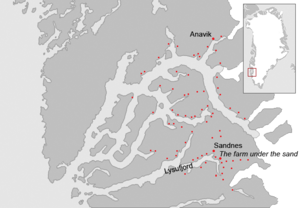Western Settlement facts for kids
The Western Settlement (called Vestribygð in Old Norse) was a group of farms and small towns. These were built by Norsemen (also known as Vikings) from Iceland. They started these settlements around the year 985 in medieval Greenland.
Even though it was called the "Western" Settlement, it was actually more to the north than west of another Norse area, the Eastern Settlement. It was located deep inside the Nuup Kangerlua fjord. This area is inland from Nuuk, which is Greenland's capital city today.
Life in the Western Settlement
We don't know as much about the Western Settlement as we do about the Eastern Settlement. Old writings about Greenland mention it very little. There are no detailed descriptions of it from medieval times.
At its busiest, the Western Settlement likely had about 1,000 people living there. This was about a quarter of the size of the Eastern Settlement. This smaller size was probably because the growing season for crops was shorter in the Western Settlement. The biggest farm in the area was called Sandnæs. Today, we have found the ruins of almost 95 farms in this region.
The Mystery of the Empty Farms
The last time the Western Settlement was mentioned was by a man named Ivar Bardarson. He was a Norwegian church official. Ivar was sent to Greenland in 1341. His job was to look after the bishop's church at Gardar in the Eastern Settlement.
After the bishop died around 1347 or 1348, Greenland did not have a bishop for many years. Ivar Bardarson was in charge of the church during this time. He decided to travel to the Western Settlement. When he arrived, he found only empty farms. No one was there.
Ivar later wrote to the Bishop of Bergen to explain what he had seen. By 1360, he had returned to Bergen in Norway. He then worked as a church leader at Bergen Cathedral.
Why Did They Leave?
The disappearance of the Western Settlement happened around the same time that temperatures started to drop. This period is known as the Little Ice Age. Summers and winters became much colder.
A study looked at how temperatures changed in the North Atlantic. It showed that summer temperatures dropped a lot starting in the late 1200s to early 1300s. They became as much as 6-8 degrees Celsius colder than modern summer temperatures. The study also found that the coldest winters in 2,000 years happened in the late 1300s and early 1400s. These harsh changes in weather likely made it very difficult for the Norse people to survive in the Western Settlement.
See also
 In Spanish: Asentamiento Occidental para niños
In Spanish: Asentamiento Occidental para niños


